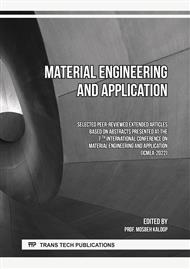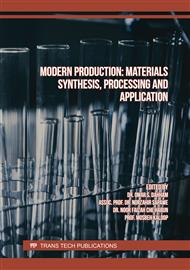[1]
I. Mukangali1, C.-S. Shon, K. Kryzhanovskiy, D. Zhang, and J.R. Kim, Effects of waste soda-lime glass sand and glass fiber on physical and mechanical properties of none-autoclaved aerated concrete,, Materials Science Forum, Vol. 1023, p.141–146, 2021. https://doi.org/10.4028/www.scientiÕc.net/MSF.1023.141.
DOI: 10.4028/www.scientific.net/msf.1023.141
Google Scholar
[2]
I. Asadi, P. Shafigh, Z. F. bin Abu Hassan, and N. B. Mahyuddin, Thermal conductivity of concrete – A review,, Journal of Building Engineering, vol. 20. Elsevier Ltd, p.81–93, Nov. 01, 2018.
DOI: 10.1016/j.jobe.2018.07.002
Google Scholar
[3]
A. Ulykbanov, E. Sharafutdinov, C.-W. Chung, D. Zhang, and C.-S. Shon, Performance-based model to predict thermal conductivity of non-autoclaved aerated concrete through linearization approach., Construction and Building Materials, vol. 196, p.555–563, 2019. https://doi.org/10.1016/j.conbuildmat.2018.11.147.
DOI: 10.1016/j.conbuildmat.2018.11.147
Google Scholar
[4]
Y. Xia, Y. Yan, and Z. Hu, Utilization of circulating fluidized bed fly ash in preparing non-autoclaved aerated concrete production,, Construction and Building Materials, vol. 47, p.1461–1467, 2013,.
DOI: 10.1016/j.conbuildmat.2013.06.033
Google Scholar
[5]
N. Almesfer and J. Ingham, Effect of Waste Glass on the Properties of Concrete,, Journal of Materials in Civil Engineering, vol. 26, Issue 11, 06014022, 2014. https://doi.org/10.1061/(ASCE)MT.1943-5533.0001077.
DOI: 10.1061/(asce)mt.1943-5533.0001077
Google Scholar
[6]
G. Lee, T.-C. Ling, Y.-L. Wong, an C.-S. Poon, Effects of crushed glass cullet sizes, casting methods and pozzolanic materials on ASR of concrete blocks,, vol. 25, p.2611–2618, 2011,.
DOI: 10.1016/j.conbuildmat.2010.12.008
Google Scholar
[7]
C.-S. Shon, A. Tugelbayev, R. Shaimakhanov, N. Karatay, D. Zhang, and J.R. Kim, Use of off-ASTM class F fly ash and waste limestone powder in mortar mixtures containing waste glass sand,, Sustainability vol. 14, 75. 2022, https://doi.org/10.3390/su14010075.
DOI: 10.3390/su14010075
Google Scholar
[8]
P. Walczak, J. Małolepszy, M. Reben, P. Szymański, and K. Rzepa, Utilization of waste glass in autoclaved aerated concrete,, Procedia Engineering, vol. 122, p.302 – 309, 2015. https://doi.org/10.1016/j.proeng.2015.10.040.
DOI: 10.1016/j.proeng.2015.10.040
Google Scholar
[9]
M.E. Arslan, B. Aykanat, S. Subaşi, and M. Maraşlı, Cyclic behavior of autoclaved aerated concrete block in fill walls strengthened by basalt and glass fiber composites,, Engineering Structures, vol. 240, 112431, 2021. https://doi.org/10.1016/j.engstruct.2021.112431.
DOI: 10.1016/j.engstruct.2021.112431
Google Scholar
[10]
R. X, T. He, Y. Da, Y. Liu, J. Li, and C. Chen, Utilizing wood fiber produced with wood waste to reinforce autoclaved aerated concrete,, Construction and Building Materials, vol. 208, 242–249, 2019. https://doi.org/10.1016/j.conbuildmat.2019.03.030.
DOI: 10.1016/j.conbuildmat.2019.03.030
Google Scholar
[11]
ASTM C109 / C109M-20b, Standard Test Method for Compressive Strength of Hydraulic Cement Mortars (Using 2-in. or [50 mm] Cube Specimens), ASTM International, West Conshohocken, PA, (2020).
DOI: 10.1520/c0109_c0109m-13
Google Scholar
[12]
ASHRAE. ASHRAE Handbook-Fundamentals. In American Society of Heating, Refrigerating, and Air-Conditioning Engineers, USA; ASHRAE: Atlanta, GA, USA, (2017).
DOI: 10.2172/5737921
Google Scholar



